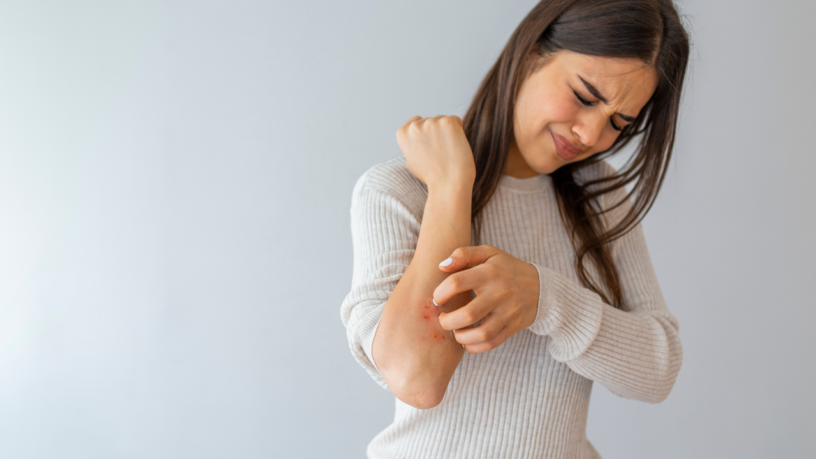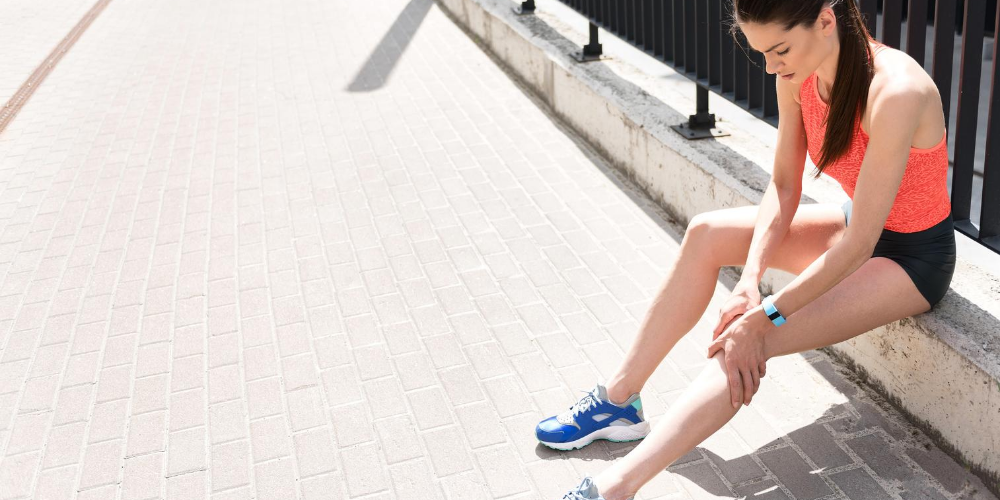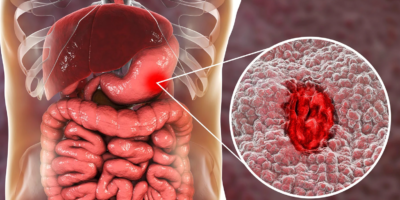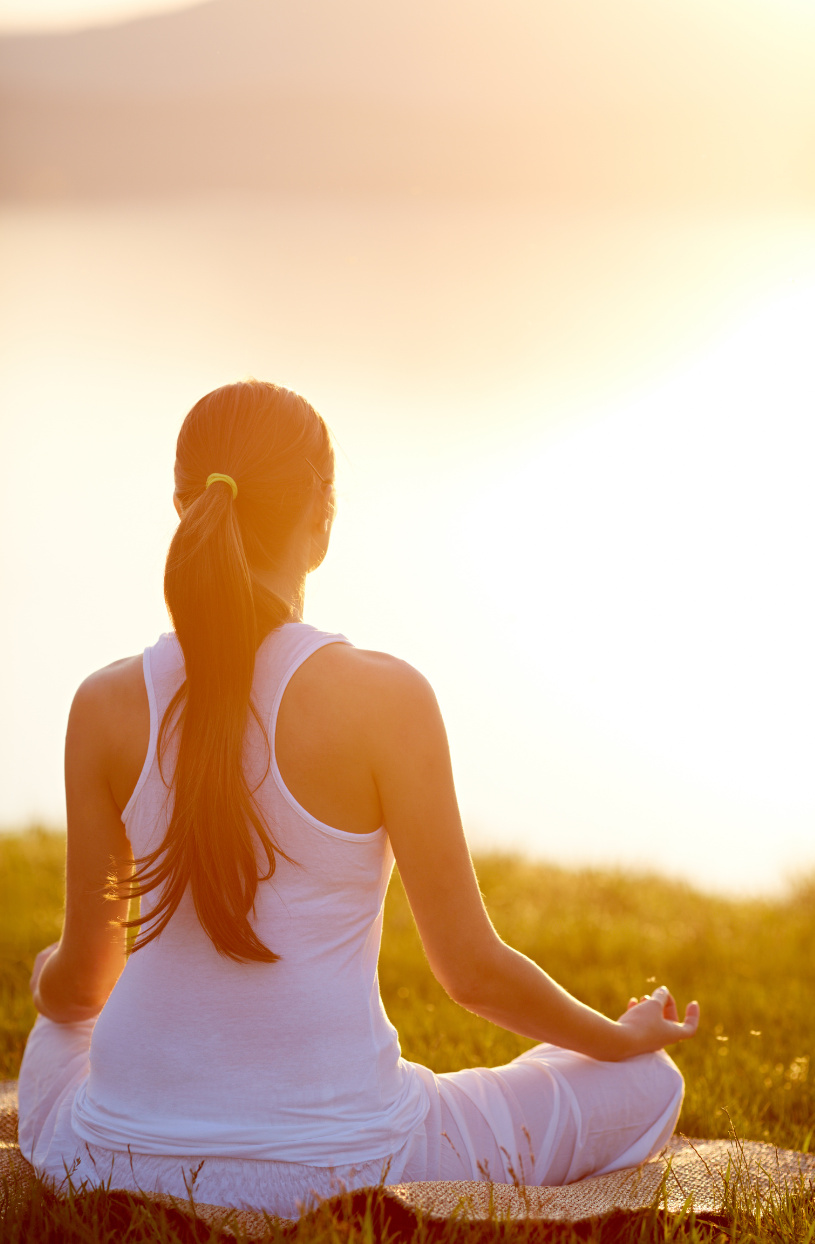Some people have eczema, also called atopic dermatitis, a condition that tends to run in families, along with hay fever and asthma. Affected patches of skin are red, itchy, scaly, and thickened, and in some cases oozing and crusty. Allergens that provoke inflammation may be difficult or impossible to identify. Hives is another skin condition often caused by an allergic reaction. Red, raised itchy patches of skin appear suddenly and may disappear as quickly as they came. Caused by a release of histamine in response to an allergen, hives can be triggered by just about anything—food, sun, dust mites, stress, medication, and more.


1. Salad Dressing to Foil Inflammation
How it works: You may think that eating oil will cause your skin to break out; in fact, oil is an anti-inflammatory. The omega-3 fatty acids in fish oil are especially effective in retarding inflammatory reactions in cells.
- PREPARATION:
- 1 part olive oil
- 1 part flaxseed oil
- 1 part balsamic vinegar
- 1 part apple cider vinegar
- DIRECTIONS: Combine all the ingredients in a dressing shaker and shake vigorously ten times. Pour over salad and toss.
- YIELD: 4 TO 6 SERVINGS
2. Colloidal Oatmeal Bath
How it works: Oats have antioxidant and anti-inflammatory activity. Applied topically, oats moisturize the skin and decrease itching. The gooeyness you feel when you squeeze the sock is caused by the complex carbohydrates in the oats.
- PREPARATION: 2 to 3 cups (160 to 240 g) regular or colloidal oats
- DIRECTIONS: If using regular oats, pour them into a food processor, coffee grinder, or blender and blend to a powder. This turns them into colloidal oats. Pour the oats into warm, running bath water. Disperse oats with your hand. (Alternatively, pour the oats into a sock, bag, or bandana to contain the particles and help with cleanup and place the sock in the bathwater.) Climb in and soak for at least 15 minutes. (Avoid using soap, which only dries and further irritates the skin.) After leaving the bath, pat your skin dry with a clean towel.
- YIELD: 01 APPLICATION
- NOTE: You can make a large batch of colloidal oats and store them in a tightly sealed jar or tin in a cool, dry place.
3. Afterbath Natural Moisturizer
How it works:
- Aloe vera gel is anti-inflammatory, soothing, and hydrating. Lab studies indicate that aloe can promote healing and may reduce inflammation in eczema.
- German chamomile (Matricaria recutita) has chemicals that reduce inflammation and allergies. More specifically, the flavonoids quercetin and apigenin inhibit the release of histamine from immune cells called mast cells. Lab studies indicate that it improves eczemalike skin conditions. The essential oil of chamomile looks blue, due to a potent anti-inflammatory chemical called chamazulene.
- PREPARATION:
- ¼ cup (55 ml) Aloe vera gel
- ¼ cup (60 ml) high-quality oil (olive, almond, coconut, apricot, or grapeseed)
- 12 drops German chamomile essential oil
- DIRECTIONS: In a clean bowl, whisk together the aloe gel and oil. Blend in the German chamomile oil. Immediately after bathing or showering, while your skin is still damp, apply a generous amount to your skin with clean fingers. Allow a couple of minutes for the moisturizer to absorb before getting dressed.
- YIELD: MULTIPLE APPLICATIONS
4. Jewelweed Rub
How it works: Urushiol, an oily resin in the sap of poison ivy, poison oak, and poison sumac, causes an allergic reaction in those who are sensitive to it. Jewelweed has strong anti-inflammatory properties. It acts on urushiol to relieve the itching and blisters and halt the spread of the rash.
- PREPARATION:
- 1 quart (946 ml) water (or more if you have lots of jewelweed)
- Armful of jewelweed
- DIRECTIONS: Bring the water to a boil in a big pot. Turn off the heat. Put the jewelweed in the pot, cover it, and let it steep for at least 30 minutes. Pour the mixture (a deep brown tea) into a gallon jar or into icecube trays and freeze. Rub on the poison ivy rash as soon as you experience the first signs of itching.
- YIELD: ENOUGH FOR DOZENS OF APPLICATIONS
5. Soothing Oat Paste
How it works: The antioxidant and anti-inflammatory activities in oatmeal relieve itching. Baking soda neutralizes the acids that promote itchy skin
- PREPARATION:
- 1 tablespoon (5 g) colloidal oatmeal
- 1 teaspoon (5 g) baking soda
- Drops of water, as needed
- DIRECTIONS: In a small bowl, stir together the colloidal oatmeal and baking soda until blended. Gradually add just enough water to form a paste. Apply to irritated areas with clean fingers. Once dry, rinse it off with warm water.
- YIELD: 01 APPLICATION
6. Poison Ivy (or Oak) Potion
How it works: The zinc oxide and ferric oxide in calamine lotion are antipruritics, or anti-itch, agents. Aloe vera gel feels cool and adds anti-inflammatory relief. This is an effective, time-honored recipe for the rash caused by poison ivy and poison oak.
- PREPARATION:
- 1 part calamine lotion
- 1 part Aloe vera gel
- DIRECTIONS: Mix the lotion and aloe gel in a clean bowl. Apply to affected areas with clean fingers, cotton swabs, or cotton balls. Allow the mixture to dry and then rinse off.
- YIELD: 01 APPLICATION
7. Scalp Therapy Oil
How it works: This natural moisturizer soothes the affected scalp.
- PREPARATION:
- ½ cup (120 ml) olive or vegetable oil
- 3 drops lavender essential oil
- DIRECTIONS: Before bedtime, warm the oil in a saucepan until it feels soothing to the touch. Apply to your scalp. Put an old cloth or towel over your pillow and sleep. In the morning, use a mild shampoo to wash away the remaining oil.
- YIELD: 01 APPLICATION
8. Sage Skin Wash
How it works: In a 2011 study in Japan, researchers used sage and rosemary, among other herbal extracts, on dermatitis lesions on mice and found that repeated applications significantly healed the skin lesions.
- PREPARATION:
- 1 cup (235 ml) water
- 1 tablespoon (2 g) dried sage
- DIRECTIONS: In a small pot, bring the water to a boil and then pour it into a cup. Add the dried sage, cover, and let steep for at least 15 minutes. Strain and allow to cool to room temperature. Apply to the affected area with a clean cloth. Allow the skin to dry before getting dressed. Do not rinse off the sage mixture.
- YIELD: 01 APPLICATION
Fact or Myth?
- MOST U.S. RESIDENTS WILL SUFFER SOME FORM OF DERMATITIS DURING THEIR LIFETIME. Yes! From diaper rash to psoriasis, up to 90 percent of the population will have allergic skin outbreaks in their lifetime.
- STRESS CAN AGGRAVATE ECZEMA. Yes! To help counteract a breakout and increasing irritation, take a long walk, bike, or swim or meditate.
- ALL CHAMOMILES HAVE THE SAME HEALING PROPERTIES. No! Roman chamomile (Chamaemelum Nobile) is a different species and chemically distinct. Although it has benefits of its own, it lacks German chamomile’s anti-inflammatory impact.
When to Call the Doctor
- You develop a rash around your eyes, mouth, genitals, or over much of your body from poison ivy or poison oak.
- Skin inflammation worsens or becomes infected, as evidenced by increased redness, heat, and pus.
- Fever or other signs of more serious illness accompany skin inflammation.






Leave a Reply